When I first came to Hokkaido years ago, I had a vague understanding that it was wilder and more rugged than the rest of Japan. So naturally, I anticipated lots of hikes, seeing some awesome scenery, and perhaps trying my hand at fishing. What I quickly realised after coming here, however, was that the island seemed perfect for doing lots and lots of cycling. My first cycling event here verified that initial hunch - I distinctly remember after completing the first stretch of the course, when my group and I turned away from the main road and into wide fields of strawberry, potato, buckwheat, and corn. The silence out there in the fields instantly struck me as sublime. We rode on in that silence, admiring the white buckwheat flowers playing in the sunshine, the balmy wind against our cheeks. But then, as if it had emerged suddenly from nothing, we all as one noticed Lake Kussharo down beyond the coloured fields, its brilliant blue surface stretching all the way north to Mt. Mokoto in the distance. That dazzling sight, framed as it was by green fields below and white clouds above, put me in a perfect trance. I had fallen in love!
Why You Need to Try Cycling in Hokkaido
Activity Guide
By Michael

And I have been cycling here in Hokkaido ever since. Let me share with you what it is that makes cycling in Hokkaido such an exhilarating and unforgettable summer activity!
Where is Hokkaido?
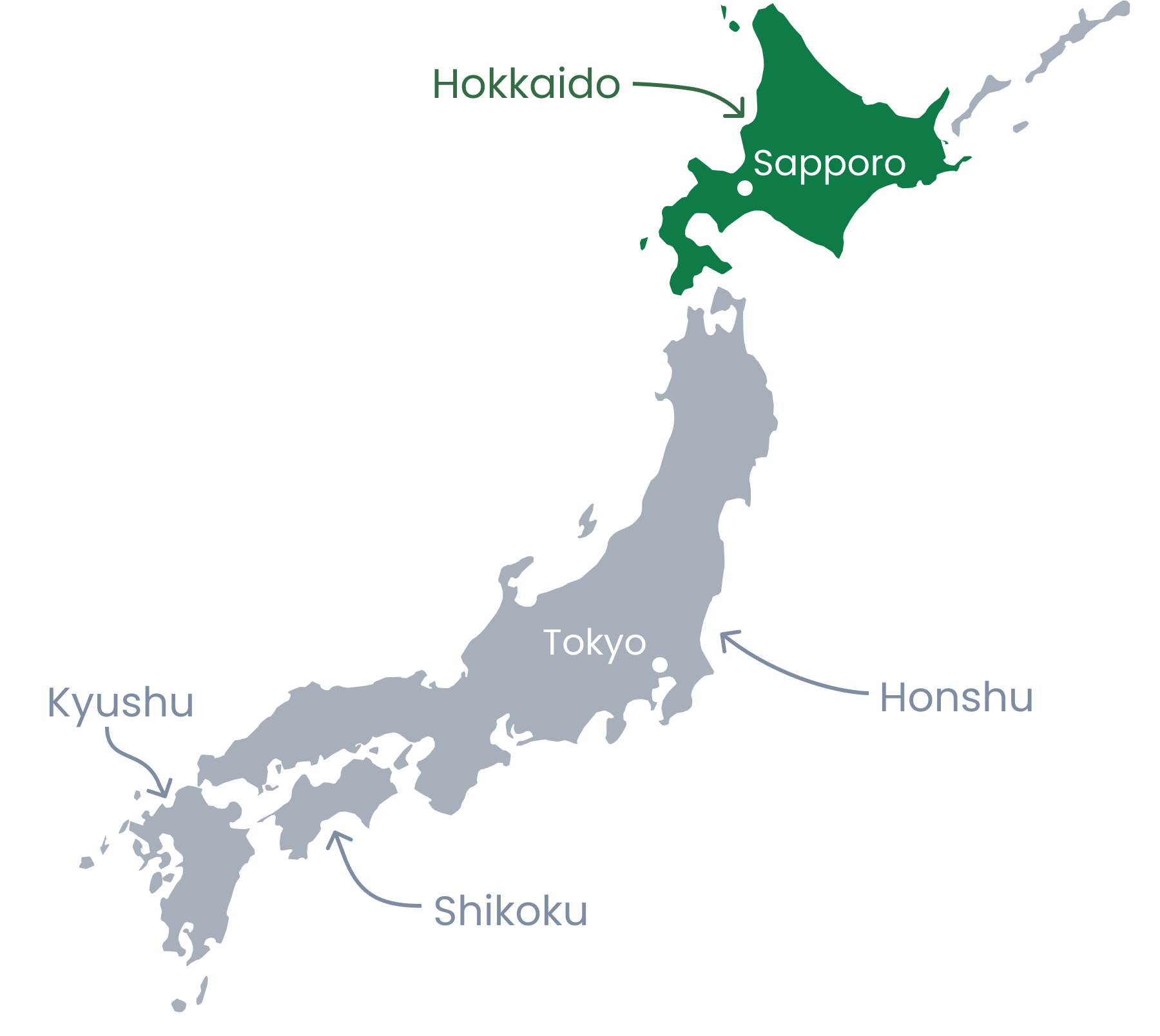
But first, let’s go over exactly what and where Hokkaido is. Firstly, it is one of Japan’s four main islands. It also happens to be Japan’s northernmost island. Hokkaido is so far north, in fact, that on a clear day, and with a good pair of binoculars, you can see Russia’s Sakhalin island from Hokkaido’s northern tip! This subarctic location means that winters here are extremely cold and the summers mild. An ice bridge used to connect Siberia to Hokkaido long ago, so much of the flora and fauna here shares similarities with that of Siberia’s, as opposed to the rest of Japan. As such, Hokkaido’s landscapes (and the wildlife found within them) are incredibly unique, making them so much fun to learn about and explore.
The Many Charms of Cycling in Hokkaido
Because of this unique geological history, the sights you will see in Hokkaido are truly unlike anything else in Japan. On a single cycling tour, you’re bound to see steaming sulfuric volcanoes one moment, only to encounter rolling wheat fields the next. And from those fields you might ride through spruce forests, cross a number of rivers, and ultimately end up taking a quick break by a beautiful lakeside, with snow capped mountains gleaming on the horizon. You might ride alongside a lonely field only to come across Red-crowned Cranes feeding beside bales of hay. You might even spot a herd of deer dashing majestically down a hill. The sheer scope of variation in landscape and the sights you see riding through it makes cycling here an absolute delight.

But it’s not only the breathtaking scenery that makes cycling in Hokkaido such an incredible activity. Because it snows so much here in winter, many roads were designed to accommodate for massive piles of snow that accumulate at the sides from regular winter ploughing. Luckily for us cyclists, this means that during the summer months there is ample space for cycling on most roads. Say goodbye to sweating bullets down a narrow bike lane! Drivers here are also incredibly polite, giving you an insanely generous berth whenever they pass. In fact, neither I nor Adventure Hokkaido guide Richard have ever been on the receiving end of a perilous “close-pass” in all our years of riding in Hokkaido, and considering that Richard has cycled over 4000km here, that certainly is saying something!
When I think about the many roads I have cycled in Hokkaido, a large number of them have been quiet, paved country roads, with not a single car in sight. So that’s another factor to consider: you will often be cycling along blooming fields with nothing but the hum of your bike’s chain contending with the birds and the rush of wind.

There is one more key factor which makes cycling in Hokkaido so great—the weather. Any summer visitor to Tokyo or Kyoto will be able to tell you that Japan is overwhelmingly hot and humid during the summer season. That much is certainly true for the southern islands, but subarctic Hokkaido is much cooler, and, perhaps more importantly, much less humid. The last thing you want on a ride is to feel sticky and languid from humidity! Even if temperatures rise to an uncomfortable degree in the daytime, they are sure to drop to a manageable level once the sun sets.
Sadly, like many other places around the world, Hokkaido summers have in recent years been getting hotter and hotter. This is the unavoidable reality! We will discuss the very best ways to stay cool and hydrated in a different section below.

So it’s safe to say that the scenery, the roads, the drivers and the weather in Hokkaido provide excellent conditions for cycling. But what about after your ride? You’ve just completed a gruelling 75km course with over 1000m of elevation, and you’re completely famished. What do you do? For me, and for many other Hokkaido locals, there is nothing better than eating a hearty local meal, and taking a relaxing dip in an onsen, or Japanese hot spring. Concerning dining options, there is so much to choose from! Some personal favourites of mine are soba, or Japanese buckwheat noodles, oyako-don, a chicken and egg rice bowl, and zangi, Hokkaido-style fried chicken (my guilty pleasure). And a visit to an onsen afterwards will relax those weary muscles that have been working so hard all day long, and restore your mind to a settled state of tranquillity. A perfect way to end the day!
Challenges and Tips
Hokkaido may be a prime location for cycling, but like any other place in the world, there are some important points to consider before setting out on your cycling journey. Let’s go over some key tips and advice in this section.
Scorchers
We mentioned above that Hokkaido summers are, on average, much cooler and much less humid than the rest of Japan, but that in recent years, temperatures have been rising. While still nowhere near as hot as Honshu or Kyushu, this has meant that the peak summer period (from around mid-July to mid-August) sometimes gets a bit too hot for comfort. Cycling during this time is still manageable, but it is absolutely essential to stay cool and hydrated while doing so.
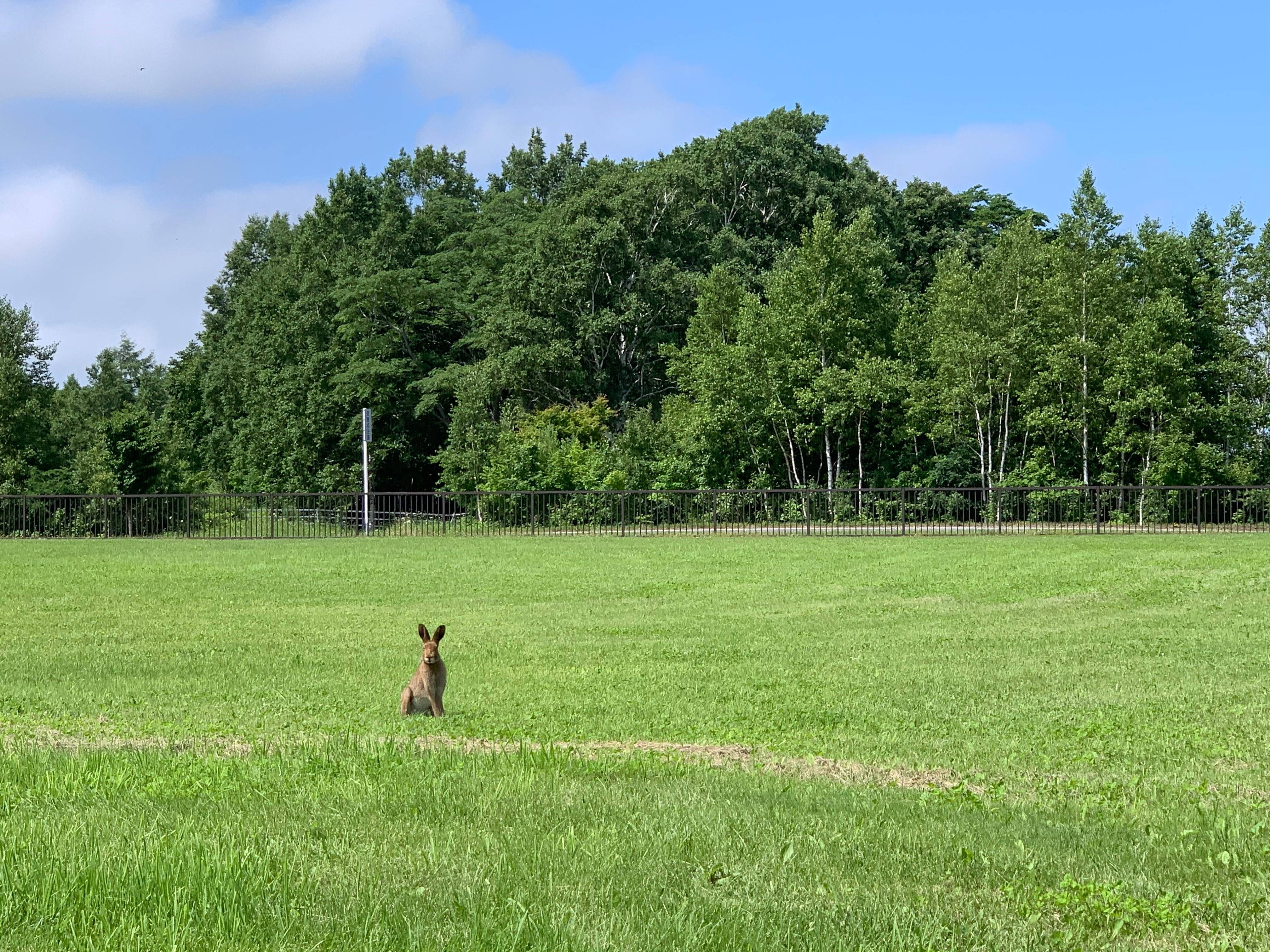
To that end, always make sure you have enough water! It should go without saying, but we think it best to emphasise. There’s no greater mistake than running low on liquids when you’re halfway up a steep slope and there is absolutely nothing around but a murder of crows cackling in a nearby tree. Luckily, both convenience stores and vending machines are practically ubiquitous in Hokkaido, so you’re never too far from a hydration station! One smart way to ensure you never run low on liquids is to keep frozen bottles of sports drinks (Pocari Sweat and Aquarius are the most popular brands) in your jersey pockets. Not only will they do an excellent job of cooling down your body, but once they melt, they’re ready to be enjoyed! If the frozen drinks won’t be enough to cool you down, wrapping a wet towel around your neck is another very quick and easy way to beat the heat.
Our Insect Friends
Another point to consider is the incredible amount of bugs. Yes, there are some biting flies here which will leave you with itchy skin, but those can easily be avoided with bug spray. They also love to bite anybody who is standing around and not moving much, so be sure to keep cycling!
What we want to emphasise over the biting flies, though, are the various bugs which are flying around the roads, and which you will most definitely collide with. Protective eyewear is therefore absolutely essential! And not just to keep bugs out. A small truck once passed me as I was cycling, and although the driver gave me a very wide berth (as Hokkaido drivers typically do) one of his tires kicked up a small pebble in the process, and that pebble flew directly at my right eye. Tap! Luckily, I was wearing protective glasses then, but just imagine if I had not been! If sunglasses aren’t your thing, then at the very least, we encourage using a transparent, non-prescription pair.
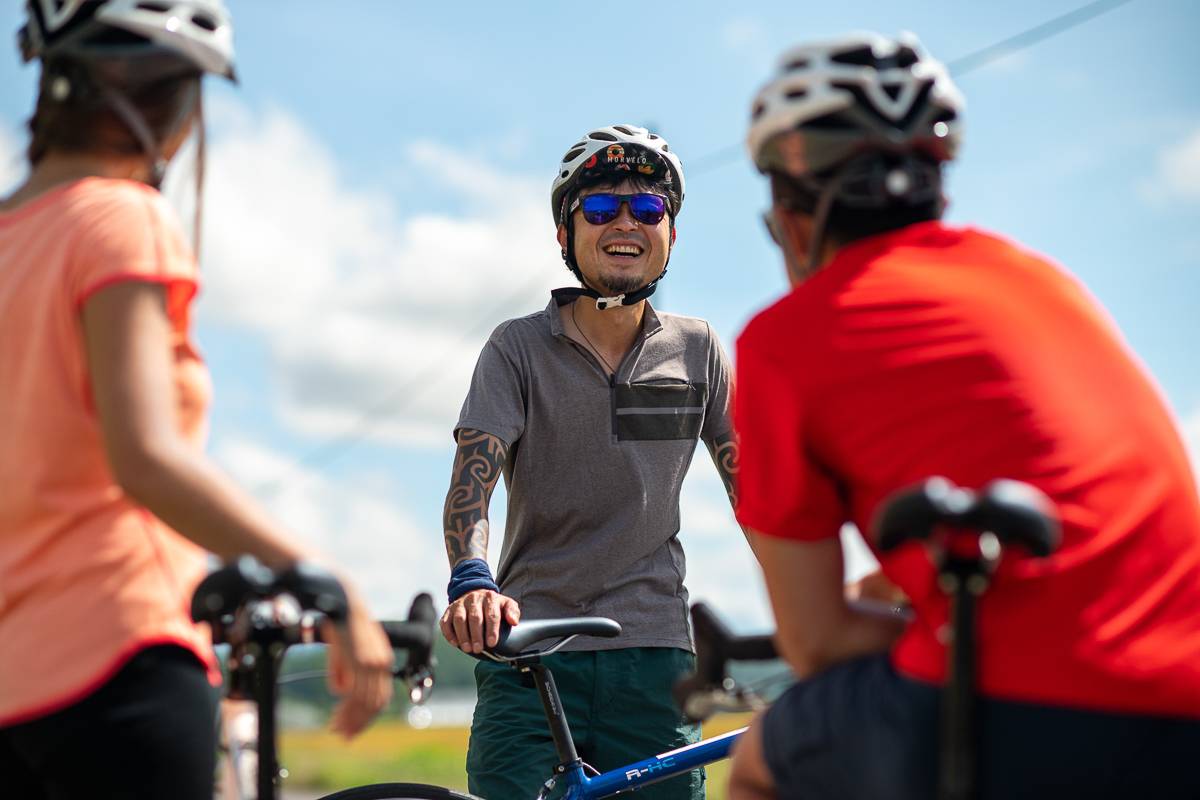
Up and Down and Up Again
Although Hokkaido’s landscape is very unique from the rest of Japan, the two definitely have one thing in common: mountains! Luckily, most of the best cycling routes here do not exceed what could be termed “moderately hilly.” So this means that experienced cyclists should feel satisfied with the amount of challenge on offer, while beginner or intermediate level cyclists will most likely not encounter any stretch of road too challenging to complete. But again, this will all depend on how much you actually enjoy the challenge of cycling! To get a better idea of what Adventure Hokkaido’s most challenging cycling tour looks like, please check out Richard's account of our Around Daisetsuzan 7 Day Cycling Tour.
You Shall Not Pass
One aspect of cycling in Hokkaido that might surprise some visitors is the amount of unexpected road closures. There are a variety of reasons behind these. Oftentimes, it’s due to inclement weather, but there could also have been a landslide, or, since this is Japan, an earthquake or a typhoon. Active forestry operations can also close down certain roads, and sometimes mountain passes may remain closed well into April because of lingering snow. With all of this in mind, practice caution when using route-planning apps which perhaps don’t have the most up-to-date information regarding Hokkaido’s roads, and which may consequently lead you straight towards a dead-end.
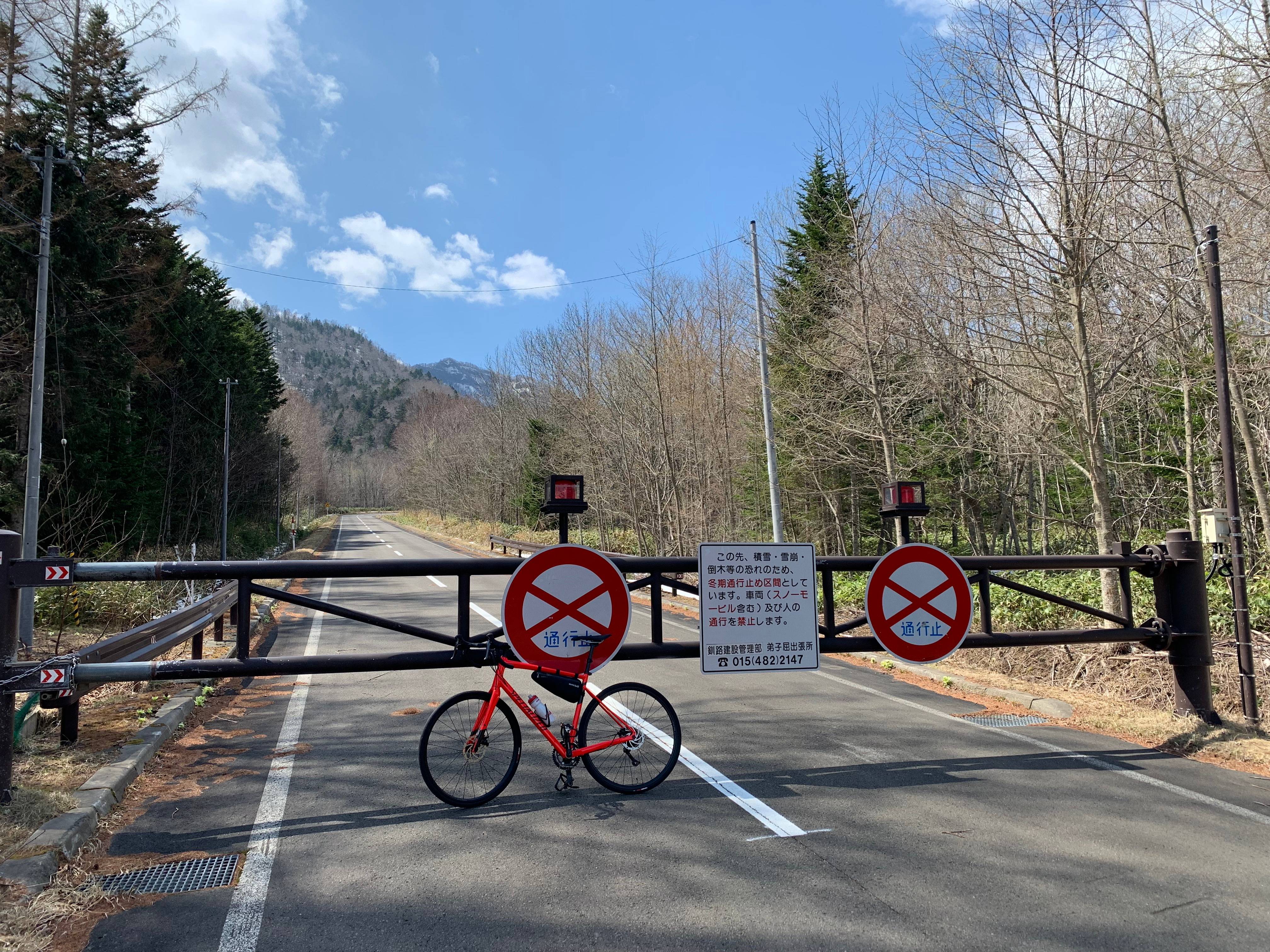
Travelling With A Bike
Let’s say that you are an experienced cyclist who owns a bicycle that you love very, very much. You love it so much, in fact, that the notion of going cycling on a rental bike fills you with sharp feelings of disquiet and dread. No need to fear! Travelling with your own bicycle in Hokkaido is perfectly doable. There are, however, some hoops to jump through in order to do so. For one, if you are bringing your bike onto a train, you must remove your front wheel and secure both it and your bike into a bicycle bag. In Japan, these bags are referred to as rinko bags. If you do not have a rinko bag to stuff your bike into, you will not be allowed to take your bike onto a train. That sounds like a sad cyclist to me!
One more headache-inducing aspect of travelling with your bicycle is that there are few bicycle-specific amenities (like bicycle racks, for instance) on trains or buses. This often results in you awkwardly positioning your rinko bag into any odd available spaces you can find on the vehicle, trying frantically not to be a burden to other passengers. So while this rinko bag system may not be the most convenient for cyclists, if done properly, you will be able to take your bicycle just about anywhere in Hokkaido.
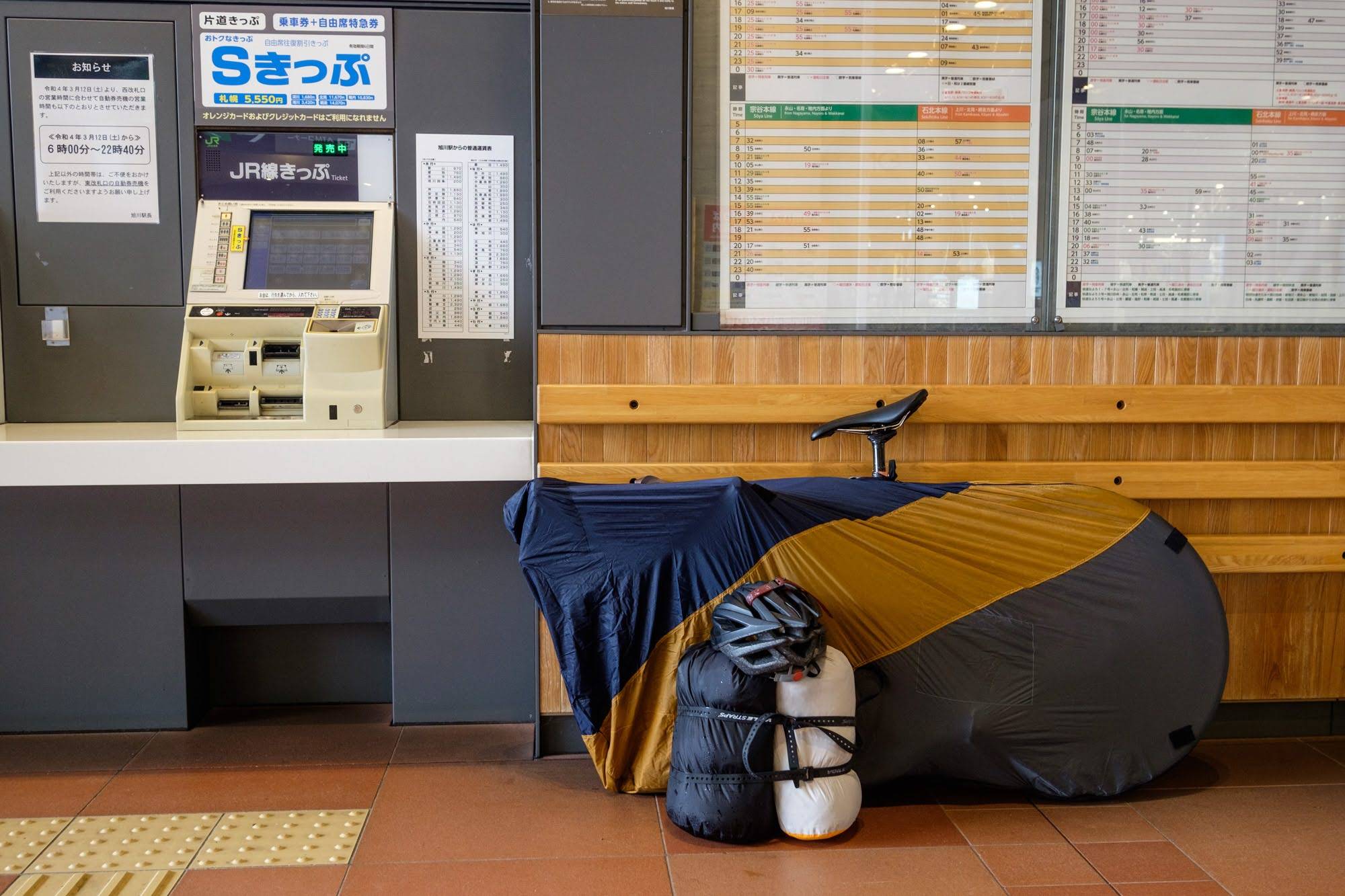
Winter Cycling? Not A Chance!
Before we move on to the next section, there is one more point we would like to stress: we do not recommend winter cycling. The reasons for this are manifold. For one, there will be snow on the ground at all elevations, not just in the mountains and the passes! Want to go for a quick ride around a low-elevation valley? Think again! There will be snow and frost and ice, and you will be slipping and sliding all over the pavement. Secondly, we mentioned in an earlier section that the roads here are engineered nice and wide to accommodate for ploughed snow. Well, those very shoulders which are empty in summer are absolutely packed with metres of snow in winter. Riding in a narrow line over slippery ice? No thank you! Our third and final point has to do with whiteout: if you’re caught in the middle of heavy snowfall, your visibility will be severely limited - and so will the drivers’! Since both you and drivers won’t be able to see well, the chance of a vehicle colliding with you rises exponentially. So in a nutshell, we do not encourage winter cycling. It’s not fun, and it’s not safe. And besides, you’ve got all summer to enjoy cycling here. Why not visit us then!
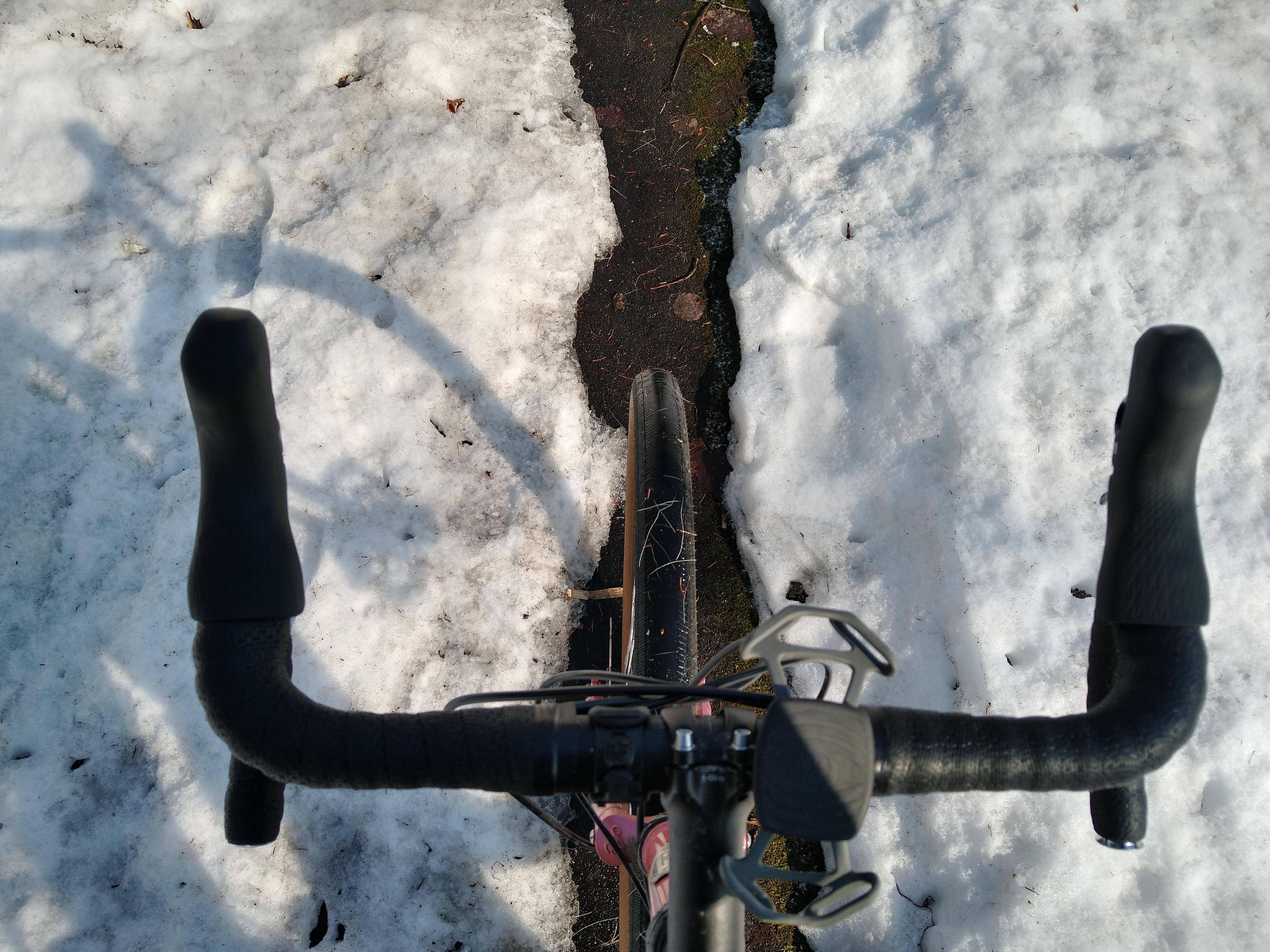
Cycling, I Choose You!
With so many ways to enjoy Hokkaido in summer, from hiking, to canoeing, to fishing, to birdwatching, you might find yourself asking, why choose cycling above the rest? While all these different activities are incredible and we encourage visitors to try them out for themselves, we believe cycling is special because it allows us to experience the island in a uniquely exhilarating way.

For one, cycling, like driving, conveys you from place to place and allows us to see some fantastic sights along the way. But unlike driving, cycling is a profoundly more “intimate” experience: as we power up that hillside, with the fragrance of summer grasses wafting in the air, the shadow of a Black Kite sweeping the road and the steady whir of cicada sounding out from the trees, we round the bend to see a distant mountain come into view, majestic and serene in the distance. We smell, we hear, we touch the island—indeed, we become one with the island itself! And that incredible feeling is something that cannot be experienced within the confines of a car. Whenever I go cycling, I can’t help but stop every time I see something worth inspecting: I get off my bike to admire a wild lily, to soak in the view of the potato fields in full bloom, or take pictures of a turquoise river running full with snowmelt. Perhaps this annoys my cycling partners (well, it most certainly does), but I simply love being able to see so much, to feel so much, while sailing through the landscape.

All of that aside, it feels immensely rewarding covering so much distance knowing that it was your own physical and mental strength alone that powered you through it. One of the most satisfying things to do after a ride is look at a map showing you the distance you covered. As you look at that visual representation, memories from the ride flood your mind - the clouds above the lake, the fox you saw scamper away across a field, the cranes you saw flying east - and you consequently feel a very special connection between yourself and the land you traversed. Again, I’m not sure any other summer activity gives us this special, “intimate” feeling.
This same intimacy can be felt when interacting with locals you meet along the way. While hiking in Hokkaido is an amazing experience, the remoteness of most hiking routes leave you far from civilisation. Cycling, on the other hand, takes you through small, populated areas where foreign visitors may be extremely rare. Say you stop at a small soba shop for a quick bite to refuel.
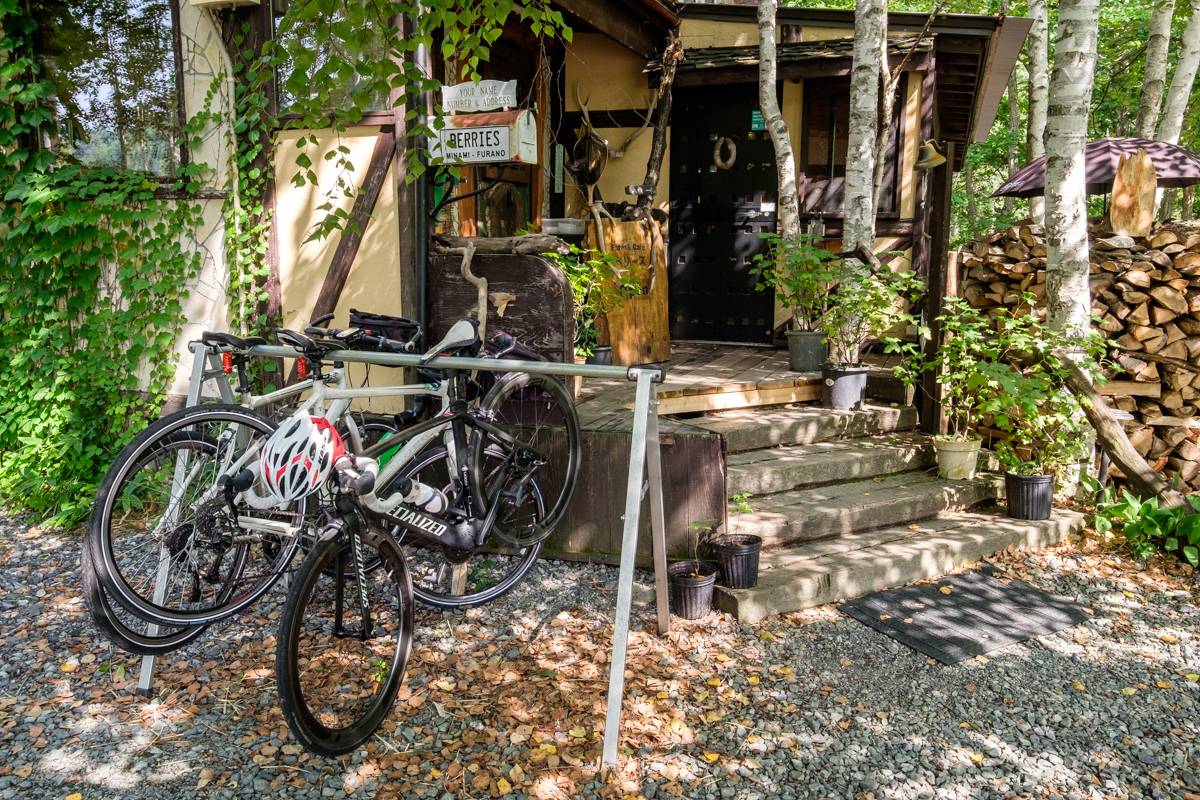
The locals and workers there might be shy, but they are just dying to ask where you are from, where you are cycling to and how long you have been in Japan, among other things. I recall years ago after a rather gruelling climb up a mountain pass, a woman came up to me and my cycling partner in sheer amazement. “Was that you two back there cycling up that steep road? Amazing!” Apparently, she had driven past us in her car on the way up! We went on to discuss where we were from, what had brought us there, and so on. Small interactions like this make cycling trips all the more memorable!
Perhaps those who have never done any serious cycling before are interested in trying it out, but feel overwhelmed at the prospect of cycling 40km+ every day for five days straight. That’s an understandable feeling. On paper, those numbers can certainly look daunting! But one of the greatest things about cycling is that, with proper pacing and smart route planning, even beginners can complete longer distances. We would say that a fairly active individual who has at least cycled short distances before can push themselves to ride these routes to completion. And besides, there is absolutely no shame in taking quick breaks to recharge along the way. No one is expecting anybody to be a Tour de France level pro. We just want to ride around this beautiful island, and experience everything it has to offer!

Of course, your experience on the island will differ depending on what kind of tour you decide to go on. There is the “Spartan” approach, in which you pack incredibly lightly, with nothing but a tent and some essentials, riding from campsite to campsite. And then there is the more comfortable ryokan-hopping option. Ryokan are traditional Japanese style accommodations similar to Western style bed and breakfasts. If you’re looking for a more luxurious option, then riding from onsen hotel to onsen hotel is your best bet. There is no better way to soothe those muscles and fully recharge for the next day’s ride!
Guided Tours
If we haven’t yet made it abundantly clear, cycling in Hokkaido is extraordinary! And we encourage everyone who is able and willing to give it a try. But we understand that flying here from across the globe, dealing with transporting your own bike, or perhaps trying to figure out bike rentals during your time in Japan can all be a monstrous headache. So let’s go over some of the ways a guided tour eliminates these annoyances, and ensures that your time in Hokkaido runs smoothly, is full of fun and excitement and leaves you with unforgettable memories.
First of all, we offer bike rentals! As such, there is no need to worry about shipping your own bike overseas, disassembling and transporting it on trains, or dealing with a third-party bike rental company once you’re here. If you book with us, you can choose whichever bike works best for you, with custom seat and pedal options, to boot. If you’d like the best of both worlds, you can even bring your own pedals or seat to attach to your rental bike—that way you can have a more familiar riding experience without having to haul around anything besides your checked luggage. Once you arrive, you will be ready to ride!

If there’s one thing that all cyclists can agree on, it’s that riding with less gear equals much more fun. Carrying a lot while riding can make cycling feel laborious and stressful. On our guided tours, there is no need to fret or worry about this: we take care of all luggage and other personal belongings. This leaves you and your bike to the wide open road!
And should you run into any mishap during your tour (a tire gets punctured at the top of a hill, or a chain becomes misaligned at the foot of a mountain, for example), our guides will be there to offer full mechanical support. In addition, there is no need to spend time thinking about which route is the best route to take. Our guides handle all route planning, and work hard to ensure you enjoy Hokkaido’s roads to the fullest.
Many Japanese cycling guides have a reputation for lining their customers up and making them ride at a set pace. This might be the preferred method for more serious cyclists, but we find that it runs the risk of making some less-experienced cyclists feel overwhelmed and exhausted. And that’s the last thing we want our guests to feel! On Adventure Hokkaido’s guided tours, you have the freedom to ride at your own pace, and thus to enjoy Hokkaido in your own way. But should you find that a certain stretch of the tour is simply too much for you to handle and you need to take a quick break to recharge, you are welcome to ride in our accompanying support vehicle. Of course, we encourage all our guests to push themselves to reach the top, but this service is on offer should anyone need it!
Come Cycle With Us!
I have made countless lasting memories cycling in Hokkaido over the years. It truly is a special way to experience the island and form an intimate connection with the land. Cycling routes here can be crafted for experienced cyclists seeking a more challenging course of ups and downs and long stretches of road. But there are also more manageable routes perfect for those who are new to the activity, and would like to give it a try for themselves. No matter your skill level, we guarantee that you will never forget your time cycling through Hokkaido’s beautiful natural landscapes!
Ready for your own Hokkaido cycling adventure?
Join us for an unforgettable cycling journey